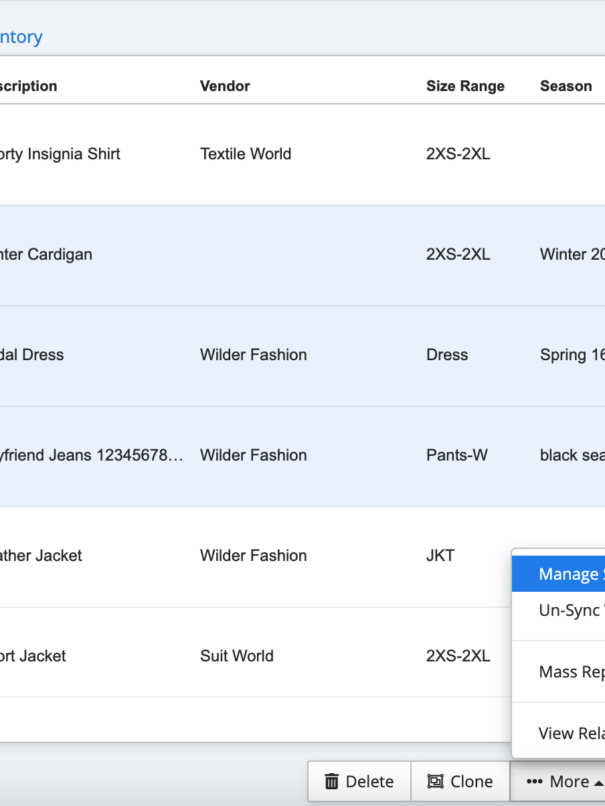Great fashion never goes out of style but clothing inventory can easily become dated and inefficient. If you aren’t on top of your inventory strategy as a business owner, your fashion retail business may suffer.
Inventory management is one of the most important factors for apparel retailers.
Regardless of the size of your fashion retail business, you must employ effective inventory management techniques and strategies to ensure its success.
But what are those strategies? And what tools will make your inventory processes simpler?
In this post, we’re discussing the importance of fashion retail inventory management and sharing 5 top strategies that will help apparel retailers oversee their stock more efficiently.

Image by rawpixel on Freepik
Why Is Fashion Retail Inventory Management Important
Here are some of the top reasons why every fashion retailer needs inventory management:
Cost reduction
The cost of storing your fashion inventory is known as the carrying cost of inventory. By monitoring your stock levels, you can make sure that you only have the products you need on hand which can help lower your carrying inventory costs.
This procedure may be automated. ERP (enterprise resource planning) software that is integrated with a warehouse management system or that has built-in inventory management modules can help you keep track of your stock levels and stock flow in real time.
Improved Supply Chain Management
Supply chain management is an essential part of fashion retail management. A properly managed supply chain can help you bring your goods to market quickly and effectively, whereas one that is poorly managed can cause delays and lost revenue.
Proper inventory management provides fashion companies with a more thorough understanding of their supply chain. It helps streamline storage and fulfillment processes by providing greater packaging accuracy, better delivery, and real-time tracking, all of which are essential for supply chain resilience.
Fewer Stock-Outs
Stock-out is a situation when you run out of the products your consumers want to buy. This can result in frustrated customers and lost apparel sales.
An effective inventory management system can assist you in preventing stock-outs by providing you with real-time visibility into your inventory levels. Thanks to low stock alerts and stock notifications, you will always be aware of inventory running low, so that you can replenish before a stockout occurs.
Improved Sales Channel Management
Keeping track of your inventory levels might be challenging if you sell your goods through several different channels. This is due to the fact that each channel has a unique inventory level, and if you don’t have a reliable way to keep track of your stock flow (how your inventory moves), you risk keeping excess stocks or insufficient inventory.
An effective inventory management system will allow you to monitor your stock levels across all of your sales channels. By linking your retail inventory management system with your eCommerce platform, your inventory levels will update automatically and you will always have access to accurate information. This way, you will be able to make more informed decisions, and offer a better online shopping experience, which will result in happier customers and an increase in sales.
Accurate Inventory Forecasting and Reports
Making judgments about your inventory can be tough if you lack accurate, up-to-date data. This is due to the fact that you won’t have the knowledge necessary to determine which are slow-moving products and which ones are selling well.
The best stock management software generates reports that will help you make more informed inventory decisions and improve your planning abilities.
Improved Communication with Suppliers and Fulfillment Partners
A good flow of information helps your inventory process and other business processes, allowing them to work together seamlessly.
An effective inventory management solution allows you to exchange information with your suppliers, fulfillment company, and other business partners electronically. This will help you build a strong relationship with each partner, save you time and money by eliminating the need for paper documents, and reduce issues with suppliers.
Better Customer Service
Today’s consumers expect free, quick shipping, simple returns, and a great customer experience and if you are unable to offer these services, they will go elsewhere.
With the aid of a retail inventory management system, you can ensure that you have the products your customers want in stock and can ship them out fast by keeping track of your stock levels to make your customers happy and ensure high levels of customer satisfaction.
Best Strategies for Fashion Inventory Management
Fashion retail inventory management is a continuous task. Here are some inventory management tips that will help you streamline your inventory.
1. Organize Your Inventory
If your inventory is well-organized, it will be much simpler and faster for your staff to locate or identify products in your warehouse space or retail store location. A well-organized retail space will also enable you to determine the precise stock level of goods that need to be ordered, thus reducing both understocking and overstocking.
2. Keep count of your inventory
Regular physical inventory counts can help you determine the exact status of your stock, enabling better management and control. Physical counts of inventory can help you minimize spoilage and dead inventory while also lowering storage costs because a precise understanding of your inventory over time will help you plan your restocking more effectively.
3. Focus on forecasting
If you want to simplify the inventory process and optimize your inventory levels, you must focus on customer demand forecasting. This enables you to find the ideal balance between storing either too much or too little and ensuring a smooth operation of your fashion retail store. There are two widely used forecasting techniques you can use: calculating the reorder points and determining the safety stock level. Economic order quantity is another inventory management method that helps make efficient inventory forecasting decisions.
An effective inventory management solution can also help you learn how to manage seasonal demand and fulfillment without raising off-season storage costs or stocking up on seasonal products that would remain unsold.
4. Use Handheld Devices
Utilizing barcode scanners or handheld devices to automate data collecting can help you streamline procedures and lower the chance of human error. For instance, you can use a scanner to rapidly and precisely document the items arriving while receiving shipments. Your system then automatically enters this data, saving you the time it would take for you to manually enter it.
Scanners can also be used for physical inventories and cycle counting. This might assist you in obtaining the most accurate picture of your inventory items so that you can manage them more effectively.
5. Invest in Fashion Inventory Management Software
Using specialized cloud-based apparel retail inventory management software ensures greater inventory accuracy and control. The best stock management solutions give you complete data visibility and a simple user experience by enabling you to upload an infinite number of photographs and files for any product.
The fact that such software provides a solution for more complex problems is by far its greatest benefit. You will be able to control your supply chain and inventory across many locations and sales channels. It will make tracking the number of products easier, guarantee that orders are sent promptly and from the closest distribution center, and improve customer satisfaction.
What’s more, you can use barcode and RFID technology to prevent any inventory errors, integrate your POS to maintain precise inventory counts, etc. You can even monitor customer demand in real time for more accurate planning, strong sales, and increased cost margins.

Image by fabrikasimf on Freepik
What If You Don’t Have Inventory Management
No matter how little your business is or how few things you sell, if you keep inventory, you need to keep track of it. The applications for inventory management solutions are virtually countless. One of the best things about stock management is that it helps you create order. When your inventory is well managed, you are aware of your stock turnover, current stock quantity, where each product is located, what needs to be restocked, whether there are products that need to re-enter usable inventory, etc.
With poor inventory management, on the other hand, your store will probably be disorganized and chaotic. You could lose out on sales if you can’t locate an item that a customer requests or if you counted incorrectly and don’t have enough of it. You have no idea whether you are dealing with shrinkage or theft, dead stocks, or phantom inventory. It’s also likely that you’re paying for extra goods that you don’t require. On the other hand, it’s possible that you’re actually understocking items that sell quickly.
Without inventory control, it is far more difficult to anticipate future sales trends, take advantage of seasonal swings, ensure accurate forecasting, and make informed plans. A store that doesn’t have effective inventory management procedures in place won’t operate to its full potential.
The Bottom Line
Any business needs inventory management software, but the retail fashion sector has unique challenges to overcome. It doesn’t matter if you have an online business that only sells through a single online channel or you have retail chains with numerous physical locations—the lack of proper inventory management can be devastating and eventually hurt your revenue.
Powerful inventory software is the future of inventory management. It is the best option for inventory management because it gives fashion companies a real-time view of their current product levels, both on the sales floor and in the stockroom. The system automatically updates as sales, customer returns, and new shipments are noted. It also syncs inventory with other business and financial operations to provide you with a real-time view of your cash flow and bottom line.







